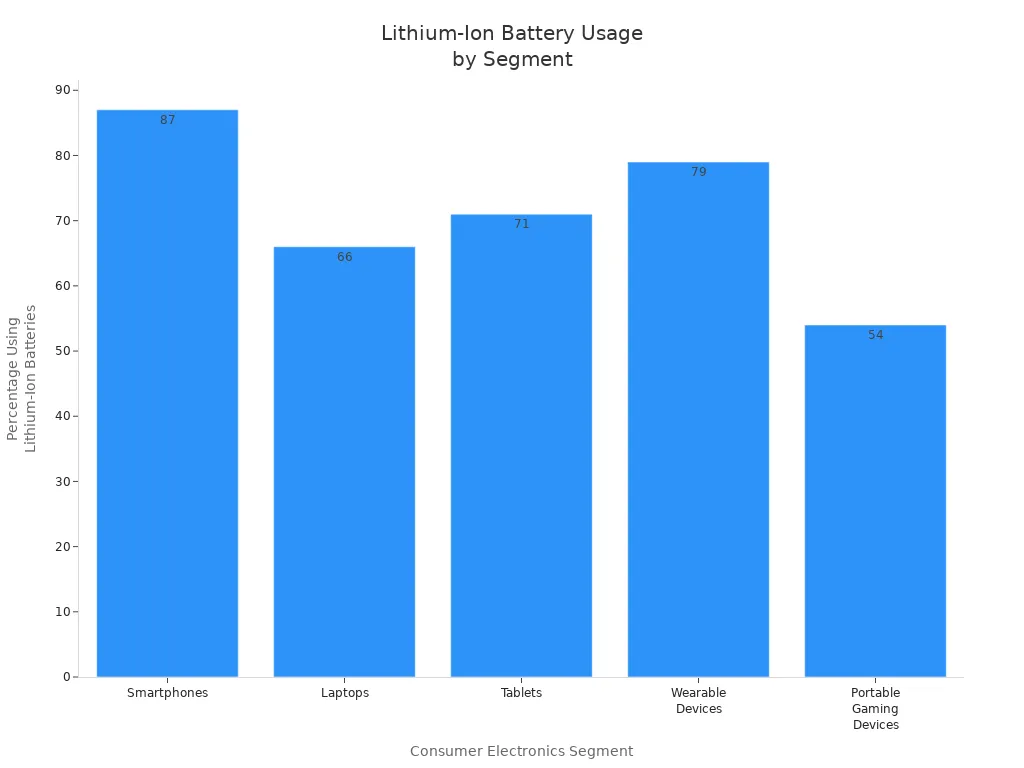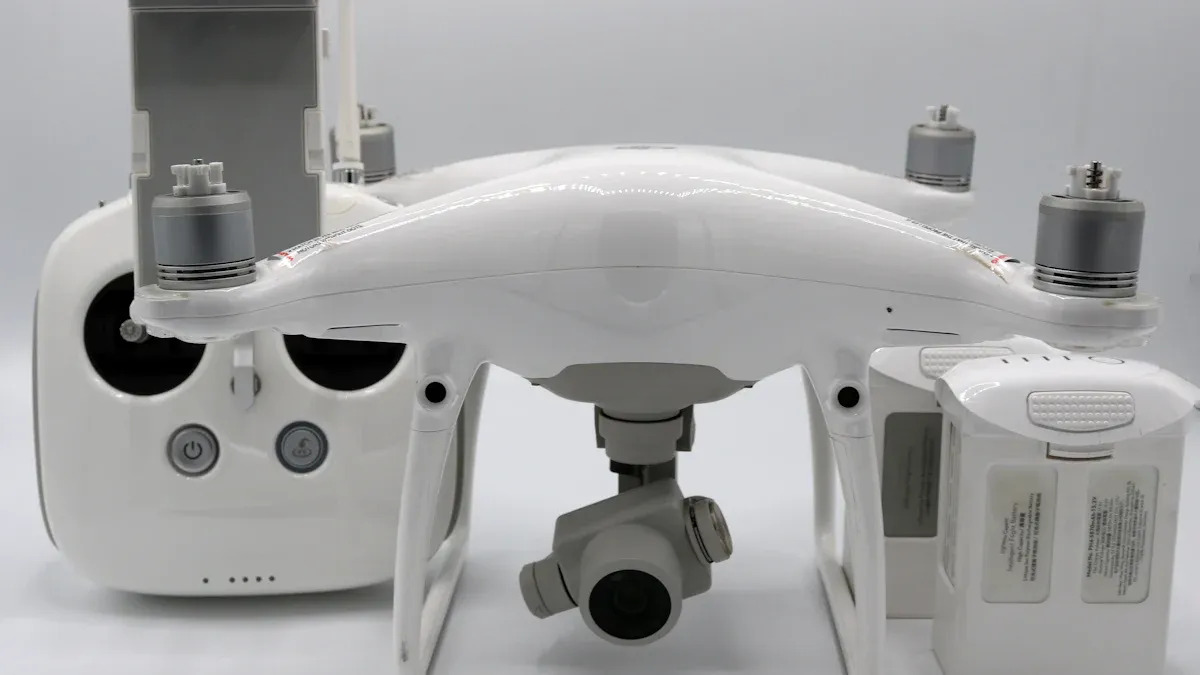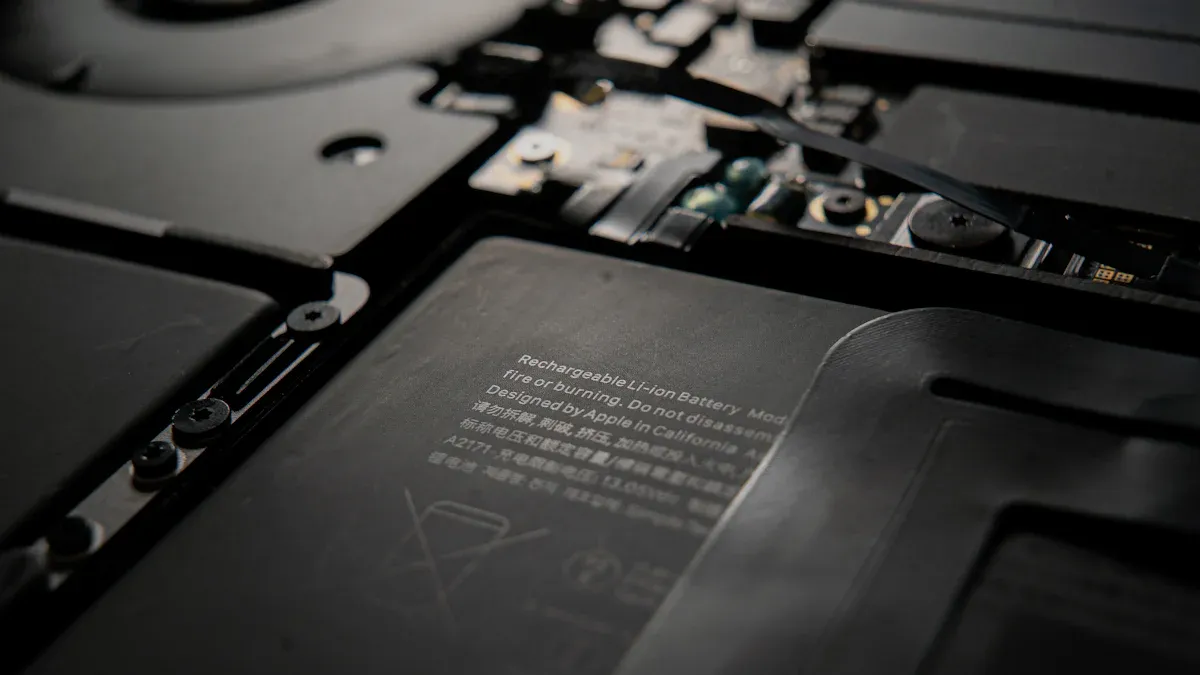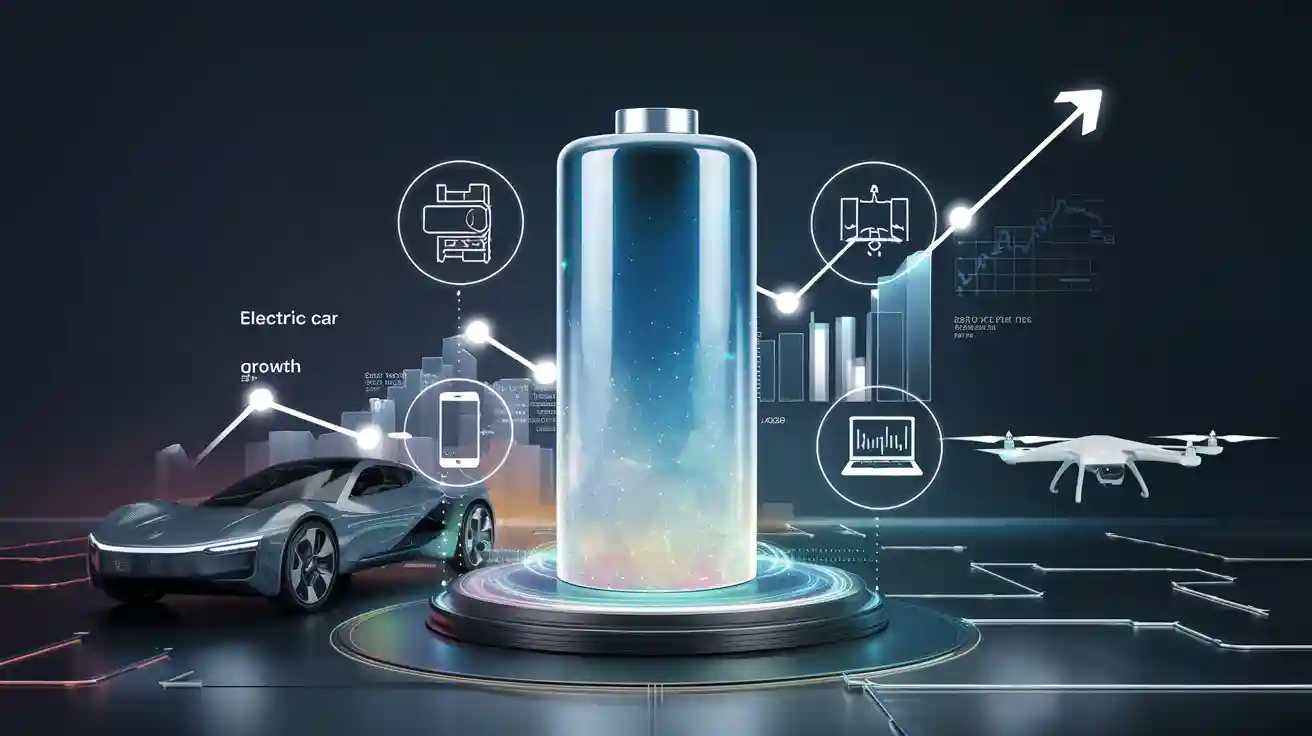Lithium-Ion Batteries Market and Wide Applications
You see the lithium-ion batteries market expanding at a rapid pace. Recent industry reports show:
- The global market reached USD 75.63 billion in 2024.
- Projections estimate USD 284.30 billion by 2032, with an 18% CAGR.
- Battery shipments could grow at a 21% CAGR through 2029.
| Factor | Description |
|---|---|
| Demand for Electric Vehicles | You notice more electric vehicles needing efficient battery solutions. |
| Renewable Energy Storage | Reliable energy storage supports the shift to renewables. |
| Consumer Electronics Usage | Your daily devices increase the demand for lithium-ion batteries. |
Key Takeaways
- The lithium-ion battery market is rapidly growing, projected to reach USD 284.30 billion by 2032, driven by electric vehicles and renewable energy.
- Lithium-ion batteries dominate the electric vehicle market, accounting for 65.24% of battery usage, thanks to government incentives that make electric cars more affordable.
- These batteries are essential for energy storage, holding 85% of the grid-scale market, and help stabilize energy supply from renewable sources.
- Consumer electronics heavily rely on lithium-ion batteries, with smartphones leading the market, highlighting the need for longer battery life and performance.
- Innovations in battery technology focus on sustainability and safety, ensuring that future batteries are more efficient and environmentally friendly.
Market Overview
Market Size
You see the lithium-ion batteries market growing rapidly across the globe. Over the past decade, the market size has increased due to new technologies and rising demand. The following table shows how the market has changed and what drives this expansion:
| Period | CAGR (%) | Key Drivers |
|---|---|---|
| 2019 to 2024 | 15.6 | More electric vehicles, higher demand for energy storage, better battery technology |
| 2025 to 2032 | 18.2 | Larger electric vehicle market, government support, more renewable energy integration |
You notice that major companies play a big role in this growth. In 2023, CATL reported USD 57 billion in revenue, LG Electronics reached USD 60.7 billion, and Samsung earned USD 54 billion. These numbers show how important the lithium battery market has become for global industries.
Growth Rate
You can track the impressive growth of the lithium-ion battery market by looking at recent data:
- The CAGR from 2024 to 2032 is projected at 17.5%.
- The market size in 2023 was about USD 56.43 billion.
- By 2032, experts expect the market to reach USD 240.90 billion.
? You see this rapid growth fueled by the rising popularity of electric vehicles and the need for reliable energy storage. More people choose electric cars, and more companies invest in renewable energy. These trends push the lithium-ion battery market to new heights.
Regional Trends
You find that different regions show unique patterns in lithium-ion battery adoption:
- Asia Pacific: China, Japan, and South Korea lead the way. China alone made up about 60% of all new electric vehicle registrations in 2023. Strong government support and investments in battery manufacturing drive this region’s growth.
- Europe: The market grows quickly here, thanks to strict emission rules and a focus on sustainability. The European Union encourages local battery production and supports renewable energy projects.
- Latin America: Countries like Brazil see a surge in electric vehicle sales and renewable energy storage. In 2023, Brazil registered 52,000 new electric vehicles, a jump of 181.1%.
- North America: The United States holds the second-largest share of the lithium battery market. You see more demand for batteries in both vehicles and consumer electronics.
You notice that Asia-Pacific holds the largest share of the lithium-ion market, driven by strong manufacturing and high demand for electric vehicles and consumer devices. North America follows, while Europe is set to grow the fastest due to government efforts to cut greenhouse gas emissions.
Growth Drivers
Electric Vehicles
You see electric vehicles leading the demand for lithium-ion batteries. These batteries power most new electric cars on the road. In 2024, lithium-ion batteries made up 65.24% of the electric vehicle battery market. You notice that government incentives play a big role in this growth. Programs like the California Electric Vehicle Incentive Project and federal tax credits help more people buy electric cars. Georgia’s tax credit also increased registrations. These incentives lower the cost for buyers and make electric vehicles more accessible. You experience mass adoption of electric vehicles because these policies reduce the financial burden. Regulatory perks, such as carpool lane access and tax exemptions, encourage you to choose electric vehicles for a cleaner future.
- Lithium-ion batteries account for 65.24% of the electric vehicle battery market in 2024.
- Incentives like tax credits and grants make electric vehicles more affordable.
- Regulatory benefits motivate you to switch to electric vehicles.
Energy Storage
You rely on lithium-ion batteries for reliable energy storage. These batteries dominate the grid-scale energy storage market, holding 85% of the revenue share in 2024. In the United States, they represent over 90% of large-scale battery storage. You benefit from advancements in technology and lower costs, which make lithium-ion batteries the preferred choice for renewable energy projects. These batteries help bridge the gap between supply and demand by storing excess energy during peak production and releasing it when needed. You see them enhancing grid stability and supporting off-grid renewable systems in remote areas.
- Lithium-ion batteries hold 85% of the grid-scale energy storage market in 2024.
- Over 90% of large-scale battery storage in the U.S. uses lithium-ion technology.
- They store excess energy, stabilize the grid, and support off-grid systems.
Electronics
You use lithium-ion batteries every day in your electronics. The consumer electronics segment is expected to hold 42.3% of the total market share in 2025. Devices like smartphones, laptops, tablets, and wearables rely on these batteries for long-lasting power. You demand high-density batteries because your devices are compact and powerful. The table below shows how different segments use lithium-ion batteries:
| Consumer Electronics Segment | Percentage Using Lithium-Ion Batteries |
|---|---|
| Smartphones | 87% |
| Laptops | 66% |
| Tablets | 71% |
| Wearable Devices | 79% |
| Portable Gaming Devices | 54% |

You notice the growth in electronics is driven by your need for portable, powerful devices. Lithium-ion batteries make this possible.
Applications of Lithium-Ion Batteries

Lithium-ion batteries power a wide range of applications across many industries. You see these batteries in vehicles, energy storage systems, industrial equipment, consumer devices, and even aerospace technology. Their high energy density, long lifespan, and lightweight design make them the top choice for modern energy solutions.
Vehicles
You notice that lithium-ion batteries dominate the electric vehicle market. Most electric vehicles use lithium-ion technology because it offers high energy density, longevity, and a lightweight structure. This dominance shows how important lithium-ion batteries are for the growth of electric transportation. You benefit from longer driving ranges and faster charging times. Hybrid and plug-in hybrid vehicles also rely on lithium-ion batteries. Manufacturers focus on increasing energy density to meet your need for longer trips. They use advanced chemistries like NMC 811 and NCA to boost performance. Battery management systems help keep your vehicle safe and efficient.
- You see higher energy density batteries for longer driving ranges.
- Manufacturers invest in new chemistries to improve performance.
- Battery management systems optimize safety and lifespan.
- Engineers use advanced design methods to maximize battery pack efficiency.
Lithium-ion batteries play a critical role in the shift to electric vehicles, supporting cleaner transportation and reducing emissions.
Energy Storage
You depend on lithium-ion batteries for renewable energy storage at home and in businesses. These batteries store excess solar or wind energy for later use, making your energy supply more reliable. In residential settings, you use lithium-ion batteries to keep your lights on during outages and to save money by using stored energy during peak hours. Commercial users rely on these batteries to improve the efficiency of solar and wind energy systems and to support the power grid.
| Application Type | Description |
|---|---|
| Residential Energy Storage | Systems that store excess energy for later use, improving living quality and energy reliability. |
| Commercial Energy Storage | Enhances efficiency of solar and wind energy utilization, supporting power grid development. |
| Microgrid | A small power distribution system that integrates energy storage with distributed power generation. |
Lithium-ion batteries offer higher energy storage efficiency than older technologies. You get 85-95% efficiency and a lifespan of up to 10,000 cycles. These batteries are compact, making them ideal for grid energy storage and microgrids. You see them as the backbone of renewable energy storage, helping you use more clean energy every day.
- Lithium-ion batteries provide 3-4 times more energy density than lead-acid batteries.
- You benefit from longer lifespans and less maintenance.
- These batteries support the growth of renewable energy by storing power for when you need it most.
Industrial Use
You find lithium-ion batteries in a wide range of applications within factories and warehouses. Robotics and automation systems use these batteries to power automated guided vehicles (AGVs) and robotic arms. You see portable tools like drills and saws running on lithium-ion batteries, which increases mobility and productivity. Security systems depend on these batteries for reliable power, and emergency backup systems keep essential equipment running during outages.
| Feature | Lithium-Ion Batteries | Lead-Acid Batteries |
|---|---|---|
| Maintenance | Zero maintenance required | Significant maintenance required |
| Charging | Opportunity and fast charging available | Requires full discharge and long charging time |
| Energy Density | Higher energy density for greater efficiency | Lower energy density |
| Productivity Impact | Less downtime, more operational hours | More downtime due to long charging times |
| Lifespan | 2,000 to 3,000 cycles (10+ years) | 1,000 to 1,500 cycles (5 years) |
| Environmental Impact | Lower carbon footprint, cleaner operation | Higher emissions during charging |
You experience faster charging, longer battery life, and higher efficiency with lithium-ion batteries. In material handling and robotics, these batteries offer lightweight, modular designs that you can scale to fit your needs. Advanced battery management systems ensure safe and reliable operation, making lithium-ion batteries the preferred choice for industrial applications.
- Lithium-ion batteries charge in 1-2 hours, reducing downtime.
- You get up to 3,000 cycles, which means fewer replacements.
- Their high energy density supports longer shifts and more productivity.
Consumer Devices
You use lithium-ion batteries every day in smartphones, laptops, tablets, and wearable devices. Smartphones alone account for about 40% of the lithium-ion battery market. Laptops and tablets follow closely, driven by the rise of remote work and online learning. Wearable devices, such as smartwatches and fitness trackers, make up around 10% of the market.
- The smartphone segment leads because you want longer battery life and better performance.
- Laptops and tablets see growth as more people work and study from home.
- Wearables grow as you track health and fitness.
Modern battery management systems use machine learning to adapt to your habits and environment. These systems optimize charging and discharging, which extends battery life. You benefit from features that manage charging patterns, keeping your devices running longer. Frequent top-up charging and limiting maximum charge levels help reduce battery aging. Advanced algorithms balance each cell, preserving capacity and performance.
You enjoy longer-lasting, more reliable devices thanks to the latest lithium-ion battery technology.
Aerospace
You see lithium-ion batteries powering a wide range of applications in aerospace. Commercial aircraft use these batteries for passenger and cargo transport, taking advantage of their high energy density and lightweight design. Military aircraft rely on lithium-ion batteries for reliable and efficient power during advanced operations. Spacecraft, including satellites, depend on these batteries for long-duration missions. Drones use lithium-ion batteries for surveillance, delivery, and research.
| Application Type | Description |
|---|---|
| Commercial Aircraft | Used for passenger and cargo transport, providing high energy density. |
| Military Aircraft | Essential for advanced military operations, offering reliability and efficiency. |
| Spacecraft | Powering satellites and other space missions, crucial for long-duration flights. |
| Drones | Enabling UAVs for various applications, including surveillance and delivery. |
Lithium-ion batteries help reduce weight in aircraft, which improves performance and fuel efficiency. Their long lifecycle means you can rely on them for many years. The high energy density of lithium-ion batteries supports longer flights and more demanding missions. You see these batteries as essential for the future of aerospace technology.
- High energy density allows for significant weight savings.
- Lightweight batteries improve aircraft performance.
- Long lifecycle ensures reliability and efficiency.
Lithium-ion batteries enable a wide range of applications in aerospace, supporting innovation and efficiency in the skies and beyond.
Technological Trends

Lithium-Ion Chemistry
You see rapid progress in lithium-ion chemistry, which leads to better performance and higher energy density. Manufacturers now use new materials and designs to meet your growing needs for electric vehicles and advanced storage systems. The table below shows some of the latest advancements:
| Advancement | Description |
|---|---|
| Integration of Silicon-Based Anodes | Achieves a theoretical tenfold increase in capacity compared to graphite anodes, crucial for high power applications like electric vehicles. |
| Pioneering Solid-State Electrolytes | Uses ceramics and polymers to enhance stability and safety, minimizing risks associated with liquid electrolytes. |
| Advancements in Lithium Metal Anodes | Offers a lightweight alternative to graphite, significantly boosting energy density, beneficial for aviation and military applications. |
These innovations help you get more power and longer life from each battery. You benefit from lighter devices and vehicles that can travel farther on a single charge.
Sustainability
You want batteries that are both powerful and environmentally friendly. Manufacturers now focus on using sustainable materials and improving recycling. Here are some ways they make lithium-ion batteries more sustainable:
- Manufacturers recover valuable materials like cobalt from used batteries, which reduces the need for mining.
- They follow strict regulations to ensure sustainable production and disposal.
- New designs make recycling easier and lower the environmental impact.
- The European Union requires that every new battery contains a set amount of recycled material.
- Production processes now avoid polluting steps, making the entire cycle cleaner.
- Companies design batteries for easy disassembly, so you can recycle them more efficiently.
You see these changes making battery production and disposal safer for the planet.
Safety
You rely on lithium-ion batteries every day, so safety matters. The most common risks include overheating, mechanical damage, and electrical faults. Here are some key concerns and how manufacturers address them:
- Temperature risks: Charging outside 5 to 45 °C can cause thermal runaway.
- Mechanical risks: Damage may lead to fire or explosion.
- Electrical risks: Overcharging or over-discharging can cause short circuits.
- Chemical risks: Leaks can harm your health and the environment.
Manufacturers use several strategies to keep you safe:
- Use high-quality materials and strong designs.
- Add battery management systems to monitor and control battery operation.
- Install thermal management systems to keep temperatures stable.
- Include safety vents to release pressure if needed.
Ongoing research continues to improve battery safety. You benefit from safer devices and vehicles as technology advances.
Market Challenges
Resources
You face significant resource constraints in the lithium-ion battery market. The availability of lithium and cobalt remains limited, with most cobalt sourced from the Democratic Republic of Congo. This concentration creates supply bottlenecks and price volatility. You see the demand for cobalt surge as electric vehicles become more popular. If reliance on cobalt continues, the cumulative demand could far exceed known reserves by 2050. The table below highlights the main resource challenges:
| Key Points | Description |
|---|---|
| Resource Constraints | Availability of lithium and cobalt sourced from limited geographical locations. |
| Supply Bottlenecks | Increasing demand has led to supply bottlenecks and price volatility. |
| Geopolitical Risks | Significant concerns regarding cobalt supply due to geopolitical concentrations. |
You notice that these issues can hinder scalability and slow down decarbonization efforts. You need new sources and alternatives to support global decarbonization.
Recycling
You see recycling as a critical part of the lithium-ion battery lifecycle. The estimated global recycling rate for lithium-ion batteries is around 59%. In 2023, over 600,000 metric tons of spent batteries were recycled worldwide, a 25% increase from the previous year. China processed over 400,000 tons, leading the world in recycling volume. The U.S. and EU also made progress, handling 95,000 and 150,000 tons respectively. Hydrometallurgical processes recover up to 95% of cobalt and 90% of nickel. You recognize that recycling reduces environmental impact and supports decarbonization by recovering valuable materials.
- Recycling rates are rising, but you still face challenges with collection and processing.
- Efficient recycling helps lower costs and supports energy sustainability.
Cost
You experience cost pressures as raw material prices fluctuate. Material use accounts for 69% of the costs associated with lithium-ion batteries. Rising prices for lithium and cobalt have led to an increase in battery pack prices for the first time in over a decade. Inflation and component price hikes drive up cell prices. Recycling can reduce costs by 44% and global warming potential by 37%. New sources of lithium may help lower costs further. You see that cost remains a barrier to widespread adoption and market growth.
You need solutions for resource scarcity, better recycling, and cost control to support the transition to clean energy and accelerate decarbonization.
Future Outlook
Innovations
You will see rapid innovation in lithium-ion battery technology over the next decade. Companies invest in new materials and smarter designs. You benefit from batteries that charge faster and last longer. Researchers explore solid-state batteries and silicon anodes. These advances help you use electric vehicles and renewable energy more efficiently. You notice that innovation drives down costs and improves safety.
Tip: Stay updated on battery breakthroughs. New products often reach the market quickly.
Policy
You play a role in shaping the future through policy support. Governments set new rules for battery recycling and production. You see stricter standards for safety and environmental impact. Many countries offer incentives for electric vehicles and clean energy storage. These policies speed up the transition to cleaner energy. You notice that global agreements push companies to use more recycled materials.
| Policy Area | Impact on You |
|---|---|
| Recycling Mandates | Easier battery disposal |
| Safety Standards | Safer devices and vehicles |
| Incentives | Lower costs for clean technologies |
Opportunities
You find many opportunities in the growing lithium-ion battery market. Businesses need skilled workers for battery design and recycling. You can start a career in research, manufacturing, or energy storage. The energy transition creates demand for new services and products. You may invest in companies that lead in battery technology.
- Explore training programs in battery engineering.
- Join forums to learn about the latest trends.
- Contact local suppliers to ask about new solutions.
The future of lithium-ion batteries depends on your choices. You help drive the transition to a cleaner world.
You see lithium-ion batteries driving growth in electric vehicles, renewable energy, and electronics.
- You benefit from ongoing innovation and smarter battery designs.
- You face challenges with resources, recycling, and costs.
- You discover new opportunities in research, manufacturing, and energy storage.
Stay curious and ask questions. You help shape the future of clean energy by learning and sharing your insights.
-

 May.2025.11.24Ternary Lithium Battery vs Lithium-ion: Complete Comparison Guide (2025 Edition)Learn More
May.2025.11.24Ternary Lithium Battery vs Lithium-ion: Complete Comparison Guide (2025 Edition)Learn More -

 May.2025.11.214S2P 18650 14.8V Battery: Complete Technical Guide, Specs, Applications & SafetyLearn More
May.2025.11.214S2P 18650 14.8V Battery: Complete Technical Guide, Specs, Applications & SafetyLearn More -

 May.2025.11.18PCM vs BMS in Lithium Batteries: What’s the Difference and Which One Do You Need?Learn More
May.2025.11.18PCM vs BMS in Lithium Batteries: What’s the Difference and Which One Do You Need?Learn More -

 May.2025.11.17Custom Li-ion Battery Design for Medical Devices (2025 Comprehensive Guide)Learn More
May.2025.11.17Custom Li-ion Battery Design for Medical Devices (2025 Comprehensive Guide)Learn More -

 May.2025.11.17The Future of Lithium-Ion Batteries: Innovation, Sustainability, and Global Market TrendsLearn More
May.2025.11.17The Future of Lithium-Ion Batteries: Innovation, Sustainability, and Global Market TrendsLearn More
















